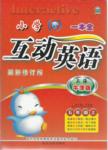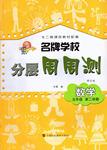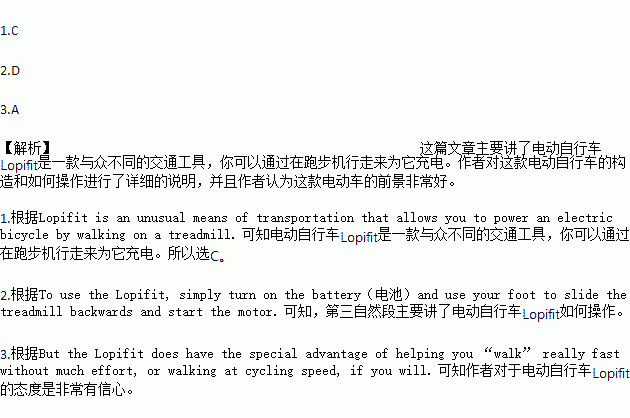题目内容
Who could have imagined that a treadmill(跑步机)on wheels would one day become a thing?!? Lopifit is an unusual means of transportation that allows you to power an electric bicycle by walking on a treadmill.

Lopifit founder Bruin Bergmeester says it all started when he asked himself the question “How can I use a treadmill outdoors?” He finally came up with a new design, adding an electric motor, and the Lopifit was born. It’s similar to an electric bicycle in that the motor only works when the rider puts power in as well. The Lopifit senses when you walk on the treadmill and uses the motor to turn a drive chain at the back of the treadmill, helping you reach a top speed of 17 miles per hour.
To use the Lopifit, simply turn on the battery(电池)and use your foot to slide the treadmill backwards and start the motor. Then get on and enjoy the ride! If you need speed, just walk on the treadmill, and if you want to coast(惯性滑行), all you have to do is stay still and admire the view. To stop, you have two hand breaks.
The Lopifit first hit the streets in 2014 and, unsurprisingly, became a hit overnight. That was actually quite challenging for the company, because it started getting calls for orders, but it was nowhere near ready for mass production. The unique treadmill bicycle could be bought this year, and Lopifit is struggling to keep up with demand, although the price is up to $2,115.
Some people consider this means of transportation stupid and unnecessary, although there is a very loyal fan-base of so-called Lopifitters. They simply believe that if you’re going to walk, you might as well do it the old-fashioned way.
But the Lopifit does have the special advantage of helping you “walk” really fast without much effort, or walking at cycling speed, if you will.
1.Lopifit is an electric bicycle which ________.
A. can be powered by the drive chain
B. can work without an electric motor
C. works when you walk on the treadmill
D. stops when you slide the treadmill forward
2.What is Paragraph 3 mainly about?
A. The design of a Lopifit. B. The function of a Lopifit.
C. The structure of a Lopifit. D. The operation of a Lopifit.
3.What is probably the author’s attitude towards Lopifit?
A. Confident. B. Concerned.
C. Curious. D. Doubtful.
 互动英语系列答案
互动英语系列答案 名牌学校分层周周测系列答案
名牌学校分层周周测系列答案
